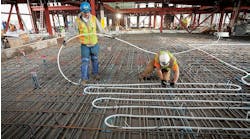Latest from Management
Sponsored
As I have shown in the articles over the past year or so, we have many choices above and beyond the well-known radiant floor for delivering excellent radiant comfort, in the heating and cooling modes. I emphasize radiant comfort in my ongoing effort to show the world that we are so much more than just warm floors.
I’d like to close this discussion by speaking of the advantages, benefits and disadvantages of each method and move on to some other ways of providing contractors the tools they need to be competitive and bring value to the table.
Radiant floors
On a Montgomery Ward scale of good, better and best, radiant floors fall into the fantastic category! They do have their application in places where people are lightly clothed, and possibly wet, like bathrooms or swimming areas. They also work well where humans are sedentary near large expanses of glass. However, they come with a higher price due to the fact that the consumer is expecting warmth from the floors everywhere he or she steps whether or not it is technically necessary. In order to be the most efficient, they should depend on conductivity as their primary means of heat transfer, which means that plateless suspended applications should be avoided if the overall goal is the highest possible thermal efficiency. While this caveat may not necessarily increase the installed cost, in the case of framed floors it most probably will because of the required use of a heat transmission plate, engineered floors or cementitious materials being applied.
Advantages: Extremely comfortable because we are in physical contact with the emitting surface. May be used in cooling applications, but are limited in capacity output due to human contact. Radiant floors are compatible with alternative energy sources with a lower approach temperature (solar and ground source heat pumps). Work best if properly controlled in high mass situations.
Disadvantages: Limited to around 30 Btus per square foot output due to human contact. Cannot handle high R value finished floor goods without severely limiting floor’s output capacity. May not be capable of carrying high load areas by itself and will require other means of thermal augmentation in order to meet the load requirements of the room.
Consumer expects warm floors at all times in all places, regardless of the time of year or room location. Radiant floors have the highest installed cost per square foot due to the fact that we need to cover every square foot with a minimum of one linear foot of pipe per square foot of space covered. In high-efficiency homes, floors will be minimally warmed, resulting in consumer dissatisfaction because they were expecting “warm floors.” They can be difficult to retrofit without creating a lot of extra work due to elevation changes and other factors.
MW Rating: Fantastic!
Radiant walls
On the MW scale, radiant walls rate “Best.” Radiant walls have the ability to deliver excellent thermal comfort. This has to do with the body’s absorption of radiant energy striking it at right angles. Think of radiant energy as a beam of light. The greater the shadow your body projects in this beam of light, the more energy (heating or cooling) your body will feel.
Radiant walls are typically limited to wainscot height (less than four feet above finished floors) to avoid the possibility of inadvertent tube strikes from people hanging pictures and such. People in most settings are spending more time in the lower regions of a room, so it works out quite well. From a retrofit consideration, it requires less “work” to blend them into a given scenario. They make extension plates for wall outlets, and window and door jam extensions are fairly simple to do. The intrusion of the walls into the living space is much easier to deal with than a change in elevation. The conductivity rules apply to all emitting surfaces, so use heat transmission plates and, when possible, apply to an internal wall to reduce back loss and insulate (blown-in insulation works) to control directional flow of warmth/cooling.
Advantages: Radiant walls can be installed for less money per square foot of living space. They can be used for heating and cooling (sensible heat only); and has a higher capacity in btuH per square of emitting surface foot due to elimination of human contact. Radiant walls require less finish work to make product finished. Also, they can be compatible with alternative energy sources, and have mass added to enhance performance when working with alternative energy sources. If a consumer wants to cover the floor with bear rugs, it will not affect the wall’s thermal capacity.
Disadvantages: Installation may require some sheetrock removal in order to complete tubing circuits, depending upon access from above or below. It does limit placement of certain large furniture items that may block them; however, my experience is that a couch will delay the delivery of energy but will not stop it, and a warm couch is very comfortable. May require augmentation in certain cases due to high heat loss areas.
MW Rating: Best.
Tune in next month as I help you continue to evaluate your options in delivering good radiant comfort from alternative surfaces.
All Mark Eatherton material on this website is protected by Copyright 2014. Any reuse of this material (print or electronic) must first have the expressed written permission of Mark Eatherton and CONTRACTOR Magazine. Please contact via email at: [email protected].
Mark Eatherton
Mark Eatherton material on this website is protected by Copyright 2017. Any reuse of this material (print or electronic) must first have the expressed written permission of Mark Eatherton and CONTRACTOR Magazine.

